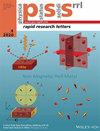Second‐order topological corner states in square lattice plasmonic metasurfaces with C4 and glide symmetries
IF 2
4区 物理与天体物理
Q3 MATERIALS SCIENCE, MULTIDISCIPLINARY
引用次数: 0
Abstract
Recently, plasmonic metasurfaces have emerged as a platform for topological photonics, exhibiting both advantages of plasmon‐induced tight confinement of local field and topological robustness. Most of previous works regarding plasmonic systems are limited to the first‐order topologies and only a few studies dealt with higher‐order topological states in honeycomb lattices. Moreover, second‐order topologies of square lattice plasmonic systems have not yet been studied. This work presents second‐order topological corner states in the square lattices of metallic nanoparticles (NPs) with various symmetries, taking two different C4 and glide symmetries as examples. Their unit cells are obtained from non‐primitive cells, consisting of four equal spheroidal NPs, by expanding (or shrinking), rotating, and resizing. Bulk bands and spectral functions of the unit cells calculated by using the coupled dipole method well agree with COMSOL simulation results, revealing the accuracy of the numerical calculations as well as the experimental realizability of the systems. Second‐order topological corner states and their robustness against structural disorder are numerically shown for three different square lattices. This work will trigger the extensive investigations to open a new realm of topological metasurfaces with promising applications.This article is protected by copyright. All rights reserved.具有 C4 和滑行对称性的方晶格质子元表面中的二阶拓扑角态
近来,等离子体元表面已成为拓扑光子学的一个平台,它同时具有等离子体诱导的局部场紧密约束和拓扑稳健性的优点。以往有关等离子系统的研究大多局限于一阶拓扑结构,只有少数研究涉及蜂窝晶格中的高阶拓扑状态。此外,方形晶格等离子体系统的二阶拓扑结构尚未得到研究。本研究以两种不同的 C4 和滑行对称性为例,介绍了具有各种对称性的金属纳米粒子(NPs)方晶格中的二阶拓扑角态。它们的单位晶胞是由四个相等的球形 NPs 组成的非原始晶胞通过扩大(或缩小)、旋转和调整大小得到的。使用耦合偶极子方法计算出的单位晶胞的体带和光谱函数与 COMSOL 模拟结果非常吻合,显示了数值计算的准确性以及系统的实验可实现性。数值显示了三种不同方晶格的二阶拓扑角态及其对结构紊乱的稳健性。这项工作将引发广泛的研究,从而开辟拓扑元表面的新领域,并带来广阔的应用前景。本文受版权保护。
本文章由计算机程序翻译,如有差异,请以英文原文为准。
求助全文
约1分钟内获得全文
求助全文
来源期刊

Physica Status Solidi-Rapid Research Letters
物理-材料科学:综合
CiteScore
5.20
自引率
3.60%
发文量
208
审稿时长
1.4 months
期刊介绍:
Physica status solidi (RRL) - Rapid Research Letters was designed to offer extremely fast publication times and is currently one of the fastest double peer-reviewed publication media in solid state and materials physics. Average times are 11 days from submission to first editorial decision, and 12 days from acceptance to online publication. It communicates important findings with a high degree of novelty and need for express publication, as well as other results of immediate interest to the solid-state physics and materials science community. Published Letters require approval by at least two independent reviewers.
The journal covers topics such as preparation, structure and simulation of advanced materials, theoretical and experimental investigations of the atomistic and electronic structure, optical, magnetic, superconducting, ferroelectric and other properties of solids, nanostructures and low-dimensional systems as well as device applications. Rapid Research Letters particularly invites papers from interdisciplinary and emerging new areas of research.
 求助内容:
求助内容: 应助结果提醒方式:
应助结果提醒方式:


